EMCECS Adapter Configuration
This section will provide you details on how to configure a storage endpoints connection string to utilize the EMCECS Adapter, which is standard with StoragePoint. Please refer to the StoragePoint Reference Guide for information on managing Storage Endpoints.
For more information on the EMCECS implementation, see the EMC documentation.
On the Application Management page, click Storage and Backup Endpoints.
Click Create New Endpoint or click the name of an existing storage endpoint that you want to edit.
Click the Show link next to the Advanced Adapter Settings to see the additional fields.
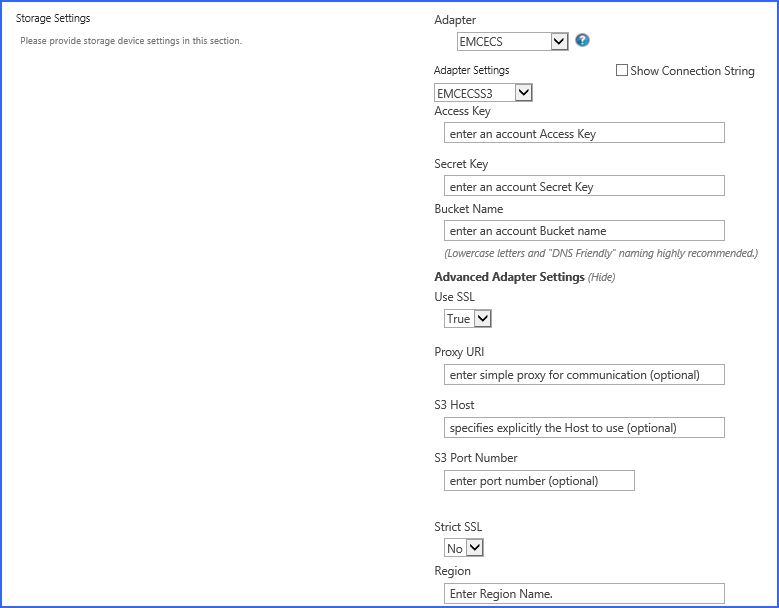
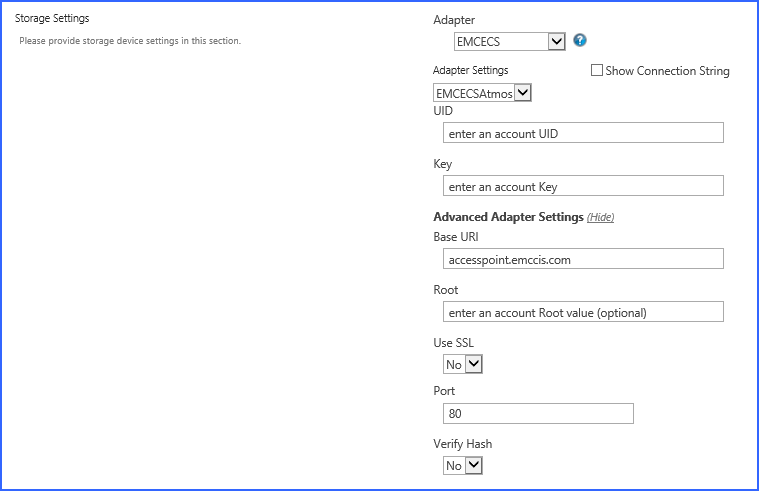
EMCECS Adapter Connection String Parameters
|
Setting
Value/Options |
|
Name
Enter the unique name of the Storage or Backup Endpoint. |
|
Type

Primary this endpoint will be available for externalization when creating storage profiles.
Backup this endpoint will be in the Backup Services dropdown on the profile page.
The selection is locked down when saving.
See Backup Services Settings in the Reference Guide for more information on how Backup Endpoints are used. |
|
Status

Online Storage Endpoint should be available to associate to a Storage Profile and accept BLOBs. (default)
Offline (Read Only) A storage endpoint can be configured, but not made available for externalizing content. The BLOBs already on the endpoint are still read only. |
|

Select the adapter for the endpoint that is being created.
|
|

After selecting the Adapter EMCECS, an additional dropdown selection must be made to designate if Atmos or S3 protocol will be used for the endpoint configuration.
|
|

ATMOS: The username to use when connecting to the server. This is equivalent to the Token ID provided with your Atmos online account.
|
|

ATMOS: The base64 encoded shared secret to use when signing requests to the server.
|
|

ATMOS: IP address or host name that represents the Atmos instance or specific node to be used. Default = accesspoint.emccis.com.
|
|

ATMOS: The starting folder/container within your Atmos namespace under which all folders and files will be created.
|
|

ATMOS: (yes/no) Determines whether or not the adapter negotiates an SSL connection for all data (and metadata) transfers. Default = No.
|
|

ATMOS: The port on the server to communicate with. Default = 80 (443 if UseSSL is Yes).
|
|

ATMOS: (yes/no) Includes a check-sum operation after each blob transfer. Allows the adapter to detect and log data integrity errors immediately. Default = No.
|
|

S3 Options
|

|
NOTE: The EMCECS adapter can be used with the Dell ECS device, using the EMCECSS3 Adapter Settings. | |
|

S3: The Access Key ID provided when you signed up for the S3 service. Required.
|
|

S3: The Secret Access Key provided when you signed up for the S3 service. Required.
|
|

S3: The container within your S3 account where content associated with a storage profile will be stored. Bucket names are case sensitive and unique across the entire S3 service namespace.
|
|

S3: (true/false) Determines whether or not the adapter negotiates an SSL connection for all data (and metadata) transfers. Default = True.
|
|

S3: Used to take the URL (optionally including a port) of a simple non-authenticating proxy that will be used when communicating with EMCECS services.
|
|

IP or DNS name that represents the access point for the Amazon AWS service.
|

|
NOTE: If a Fully Qualified Domain Name (FQDN) is used in "S3 Host", the IP address which points to the primary DELL EMC ECS storage node needs to be associated with a bucket; either via DNS record or via local OS "hosts" file:
<primary DELL EMC ECS storage node> <bucket name>.<FQDN>
It is also required to provide a new "Base URL" containing an FQDN (example below):
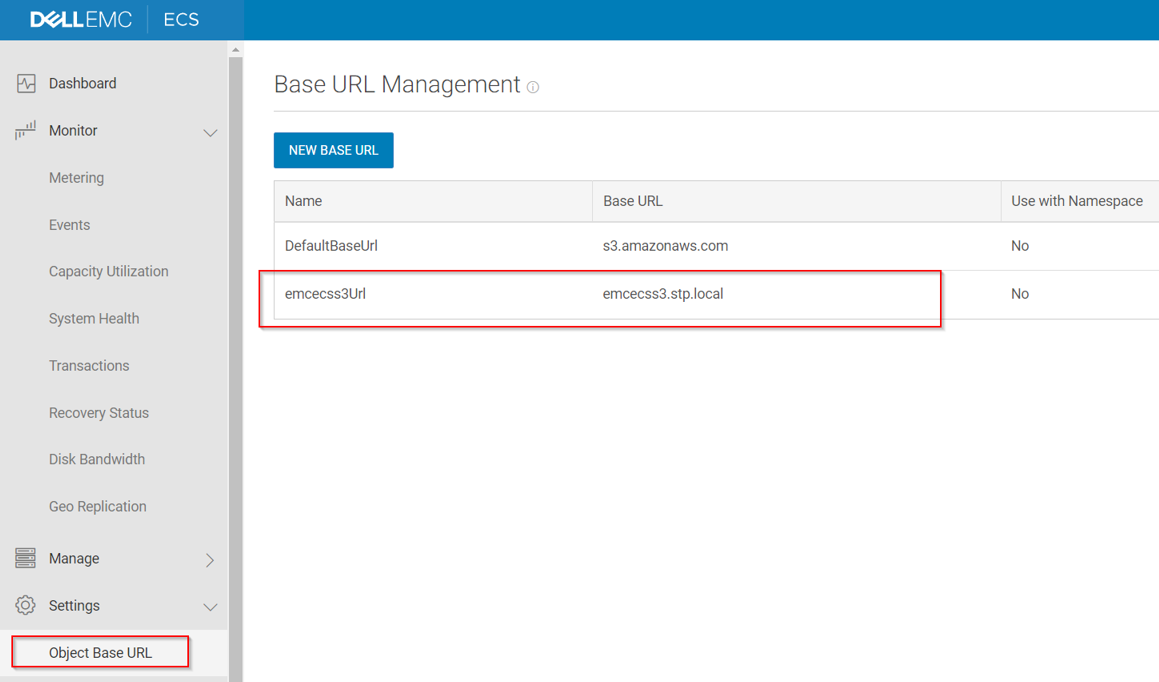
| |
|

Port used to access the S3 service. Default = 9020 for http and 9021 for https.
|
|

(Yes/No) If UseSSL is Yes, the StrictSSL flag controls whether or not the use of "self-issued" or otherwise suspicious certificates on the system will be tolerated.
|
|

Used in AWS4 request signing, this is an optional property; change it only if the region cannot be determined from the service endpoint.
For custom or private clouds or where StoragePoint cannot automatically retrieve the region because of security or permission reasons. |
Example Storage Endpoint using EMCECS Adapter
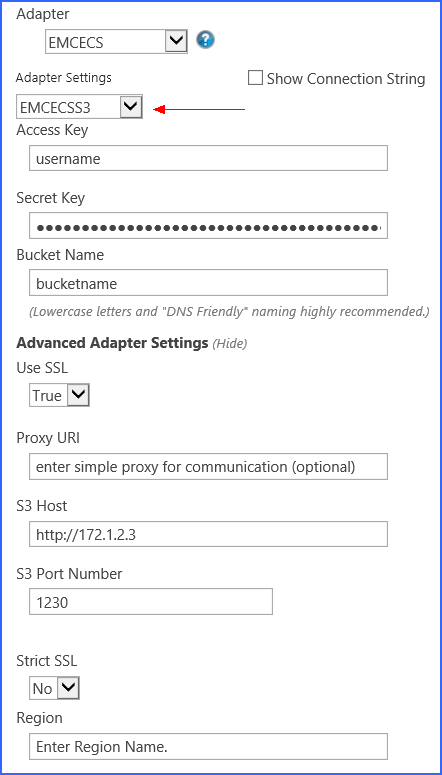
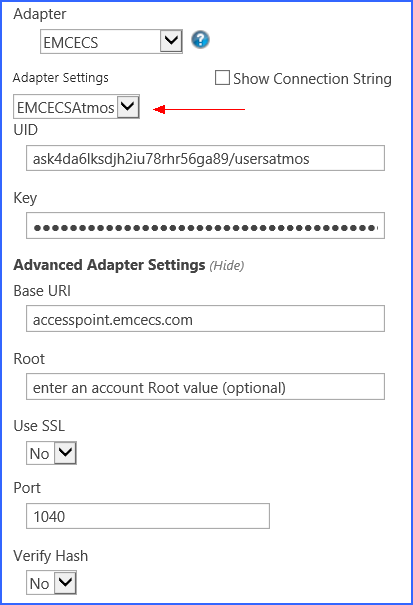
Click the Show Connection String checkbox to edit the connection string. Otherwise, fill in the connection fields shown for the adapter selected. Notice that the connection string parameters are name/value pairs separated by semi-colons.
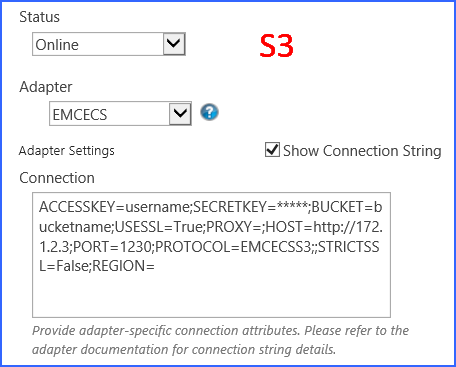
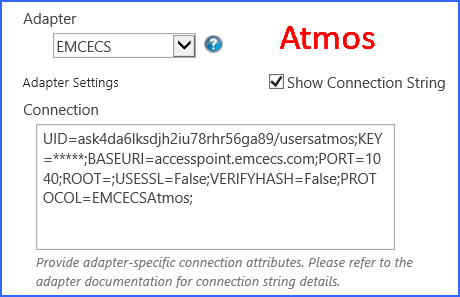
|

|
NOTE: Adapter parameters are not case-sensitive. |
|

|
NOTE: You should always use a passphrase when generating encryption keys. The passphrase gives you a means of re-creating keys should they become unrecoverable or corrupt. It is very important to remember or record the passphrase outside of Metalogix StoragePoint. Otherwise, encrypted content could become irretrievable in the event of a database failure. |
If you choose to externalize content you should test the storage profile settings by clicking the Test Storage Settings button. A message under the button will indicate whether or not the test was successful. If the test fails the message will include the error that was the root cause of the failure.
|

|
NOTE: When testing access to an endpoint from within Central Administration, the Identity of the Application Pool hosting the Central Administration Site is the one that is being used for the test. If there are different Identities used for other Web Applications in the Farm then those identities will also need access but cannot be tested from within Central Admin itself. See BLOB Store Security and Metalogix StoragePoint Required Privileges in the Metalogix StoragePoint Reference Guide. |
Appendix: Troubleshooting